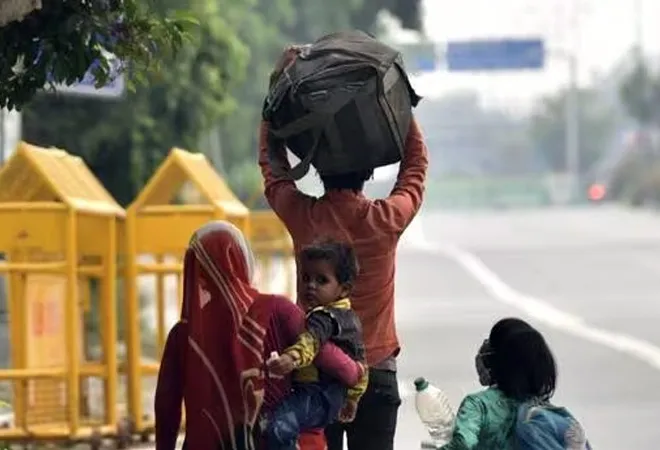
Despite the rapid demographic expansion in a limited number of megacities, India’s urbanisation has stalled. From 17.3 percent in 1951, it increased to 31.16 percent in 2011 at an average of 2.31 percent per decade. While the United States (US) took one-and-a-half centuries to reverse the rural-urban population ratio (80 percent rural and 20 percent urban to 20 percent rural and 80 percent urban), China will achieve it in a century. Looking at the past urbanisation rates in our own country per decade, India may take over two centuries to reach the 80 urban/20 rural ratio. Given that rapid urbanisation has been a primary instrument behind the sustained long-term economic growth of countries, more vigour and thought need to be put into urbanising India faster.
Studies have established that urban settlements attain larger demographic profiles via four methods. The first is the natural multiplication of the existing urban population. The second is the physical expansion of a city’s boundaries by merging peri-urban or rural areas. The third device is through reclassification, meaning that settlements hitherto classified as rural now get labelled as urban by declaring a village as a municipality. The fourth method, and the subject of this article’s discussion, is rural-to-urban and urban-to-urban migration. This entails the movement of rural people from villages into towns or cities. It also comprises people who reallocate themselves from one urban settlement to another.
Looking at the past urbanisation rates in our own country per decade, India may take over two centuries to reach the 80 urban/20 rural ratio.
In regard to rural-to-urban migration, the decennial Census data reveals that between 1971 and 1981, there were 9.3 million migrants; between 1981 and 1991, a total of 10.6 million migrants moved to cities; and between 1991 and 2001, 14.2 million migrants were added to urban settlements. These migrants made up 18.6 percent, 18.7 percent, and 20.8 percent of all additions to cities and towns. This means that the net rural-to-urban migration contributed an average of 19.36 percent to the urban population in the three decades between 1971 and 2001.
Table: Urban demographic growth in India: Percentage Contribution of different sources
| Source |
Average Percentage over 3 decades |
| Natural Increase |
56.63 percent |
| Net Reclassification & Mergers & Others |
24.01 percent |
| Net Rural to Urban migration |
19.36 percent |
Source: Census 1971, 1981, 1991, 2001
The table above shows that natural increase accounted for an average of 56.63 percent of all urban additions during the three cited decades. In numbers, there was an addition of 24.9 million, 35.4 million and 39.3 million people to urban settlements in each of the three decades. Net reclassification from rural to urban added 9.3 million, 9.8 million, and 8.4 million people between 1971-2001. Census data shows that between 1971 and 2001, India added 2,571 new towns and urban agglomerations. We may include the physical expansion through mergers into this category. This added an average of 16.03 percent of all additions. The remaining 8 percent can be ascribed to other reasons. Thus reclassification, mergers and other causes contributed 24.01 percent to urbanisation.
The conclusion that can be arrived at through the cited data is that natural increase was the largest cause of urbanisation—a little more than half. Reclassification, mergers and other causes totalled about a fourth of all additions. This was followed by rural-to-urban migration, accounting for about a fifth of the urban addition. Recent National Sample Survey Organisation figures give us a good glimpse of the reasons for rural-to-urban migration. The search for employment and marriage were the two leading causes.
Census data reveals that between 1971 and 1981, there were 9.3 million migrants; between 1981 and 1991, a total of 10.6 million migrants moved to cities; and between 1991 and 2001, 14.2 million migrants were added to urban settlements.
Today, India’s urbanisation is decidedly low when we compare the percentages of urbanisation in India with developed countries. It can be assumed that a natural increase contributing to urbanisation is not likely to exceed the current levels in percentage terms, with fertility rates stabilising in the country and going down in urban areas more than in rural. Net reclassification and mergers of rural areas into towns and cities is also a process that moves at its own pace and is likely to continue contributing between 10 to 20 percent as in the past. It is the rural-to-urban migration that has the potential to speed up urbanisation. However, this has not been happening at the pace the country needs.
In this regard, it is useful to look at China. Its enormously swift urbanisation was propelled by its unprecedented rural-to-urban migration that increased from 6.57 million in 1982 to 221.43 million in 2010, with an annual surge rate of around 10 percent over several years. As a consequence, China reached approximately 63 percent of urbanisation in 2021 from 15 percent in 1960. This happened primarily as a conscious policy decision at the national level, which led the country to relax the restrictive ‘hukou’ system of registration and allow villagers in large numbers to get into cities. Even more interesting is that China channelled its urbanisation into medium-sized cities and largely contained the phenomenon of urban sprawl.
Measures to reach the target
It is imperative that we look at ways in which rural-to-urban migration picks up much greater speed. To achieve this, the Government of India and state governments need to set a target—India will double its urbanisation in the next 40 years to reach 60 percent urbanisation by 2060 (presuming the urbanisation level today is around 35 percent). This would mean doubling the last decadal urban growth rate between 2001 and 2011 of 3.34 percent. This should be doable if three initiatives are launched.
A recent report of the World Bank estimates that India will need US$840 billion in investment into urban infrastructure over the next 15 years at US$55 billion per year.
The nation is already putting great effort into building national connectivity through a massive network of national and state highways. It is putting equal emphasis on its rail network and the quality and speed of our trains. This will have a spin-off effect in terms of aiding urbanisation. However, urban infrastructure remains poor. City roads, water supply and sewerage systems, affordable housing, rental housing, health and education infrastructure, as well as recreational facilities, need to be seriously invested in so that people are willing to come and live a decent life in urban settlements, irrespective of their level of earnings. A recent report of the World Bank estimates that India will need US$840 billion in investment into urban infrastructure over the next 15 years at US$55 billion per year.
However, even before infrastructure is pumped into the usual cities, where the investments are likely to show diminishing returns, India needs to select 500 cities and towns across the country that possess the innate potential to develop into vibrant urban centres with the strong possibility of building an economy that will attract populations for employment. Plugging the overall ‘urban destination deficit’ is a sine qua non for speeding up urbanisation by providing viable alternatives rather than restricting it to a limited number of megacities. Their spread over the country will encourage villagers, who like to keep linkages with their villages, to come to cities and become a part of the urban workforce.
Manufacturing industries would have to be provided incentives to locate themselves in such cities and towns. In creating such an economy, space would also have to be found for the informal kinds of employment that cities and their formal sector generates. Since the factor of marriage is a leading migration cause for women—as they follow their husbands into cities—making women a very large migrant group, cities will have to plan themselves as gender-friendly settlements that allow women to settle in their new locale for employment and shelter.
It is abundantly clear that India’s urbanisation needs serious conceptual and financial inputs if it has to be pushed into the fast-track lane. The country scarcely has an option.
Ramanath Jha is Distinguished Fellow at the Observer Research Foundation
The views expressed above belong to the author(s). ORF research and analyses now available on Telegram! Click here to access our curated content — blogs, longforms and interviews.




 PREV
PREV


